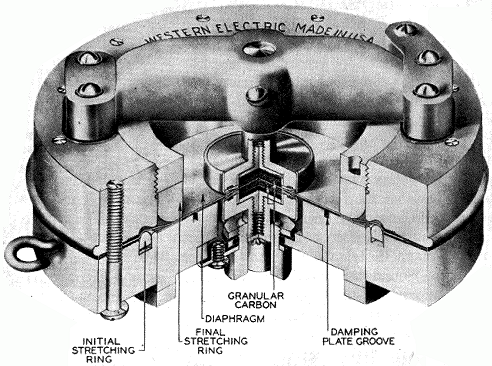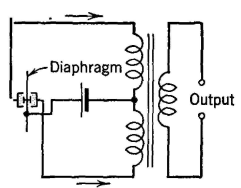| Electrical Communication is a free textbook on the basics of communication technology. See the editorial for more information.... |

|

Home  Electroacoustic Devices Electroacoustic Devices  The Double-Button Carbon- Granule Microphone The Double-Button Carbon- Granule Microphone |
|||||||






|
|||||||
The Double-Button Carbon-Granule MicrophoneThis microphone has been extensively used in radio-broadcast and sound-amplifying systems. It is still used where high output is important. A cross section of a typical microphone is shown in Fig. 7. The diaphragm of this microphone11 is of Duralumin, 0.0017 inch thick, and is clamped securely at the outer edge to prevent slipping. The portions of the diaphragm in contact with the carbon granules are covered with a film of gold to ensure a low-resistance contact. The buttons are cylindrical and provided with a paper seal to prevent carbon leakage.
Connections for a microphone of the double-button type are shown in Fig. 8. The current passes through the two buttons in series, each of which has a resistance of about 200 ohms, giving an output impedance of 400 ohms resistance. When no sound waves excite the diaphragm, the resistance is constant, and, since the primary currents are equal and in opposite directions, no magnetization is produced in the core of the transformer. When sound waves strike the diaphragm, however, the current is increased in one button and decreased in the other and a voltage is induced in the transformer secondary. The diaphragm is stretched tightly and has a high natural frequency. Furthermore, as Fig. 7 indicates, the diaphragm is very close to a grooved metal plate which provides an air-damping chamber. This construction tends to make the output independent of frequency (Fig. 9), but this high quality is obtained at a sacrifice of sensitiveness. It has been stated12 that the output of microphones of this type is about 10-8 watt and that this is of the same order as the speech power picked up by the microphone. In other words, the microphone does not amplify the speech power received by it from the sound waves like the transmitter used in regular telephone service. The output is, nevertheless, much greater than that of any other of the microphones to be considered in the following pages. This is a decided advantage in many instances.
Typical current values are 25 milliamperes per button. The current should always be reduced to about zero value before opening the battery circuit. If this is not done, the high voltage induced in the transformer windings when the switch is opened may cause the carbon granules to arc across and thus injure the microphone. A filter system consisting of a 0.0014-henry choke coil in series with each line wire and a 0.02-microfarad condenser directly across each of the two transformer primary windings is sometimes used to reduce arcing.
|
|||||||
Home  Electroacoustic Devices Electroacoustic Devices  The Double-Button Carbon- Granule Microphone The Double-Button Carbon- Granule Microphone |
|||||||
Last Update: 2011-05-03




